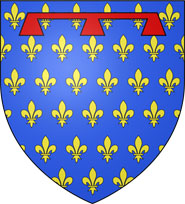 The Angevin dynasty was established in the county of Anjou, France. In the 12th century, the dynasty ascended to the English throne under Henry II as a result of the marriage of Geoffrey of Anjou to Maltida, daughter of Henry I. King Henry II’s descendants became the Platagenets, and the Plantagenet house ruled England until Richard III died at the Battle of Bosworth Field in 1485.
The Angevin dynasty was established in the county of Anjou, France. In the 12th century, the dynasty ascended to the English throne under Henry II as a result of the marriage of Geoffrey of Anjou to Maltida, daughter of Henry I. King Henry II’s descendants became the Platagenets, and the Plantagenet house ruled England until Richard III died at the Battle of Bosworth Field in 1485.
In 1203, Philip II of France took the county of Anjou from King John of England.
Charles I, Count of Anjou, founded a second Angevin dynasty, a cadet branch of the Capetian dynasty, around 1266. This dynasty ruled in Naples and Sicily until 1422, even though the revolt of the Sicilian Vespers in 1282 caused Charles to flee Sicily.
Main source:
O’Brien, Patrick K., gen. ed. “Angevin dynasty.” Encyclopedia of World History. Copyright George Philip Limited. New York: Facts On File, Inc., 2000. Ancient and Medieval History Online. Facts On File, Inc. http://www.fofweb.com/activelink2.asp?
ItemID=WE49&iPin=ewh00249&SingleRecord=True (accessed February 8, 2010).
Additional Reading / References:
- Medieval Sourcebook – Angevin England
- Royalty.nu – English Royal History – The Angevin Dynasty
- England under the Norman and Angevin Kings, 1075 – 1225 by Robert Bartlett
- England under the Angevin Kings, Vol I. by Kate Norgate